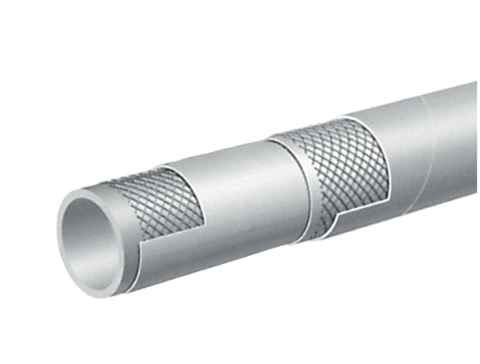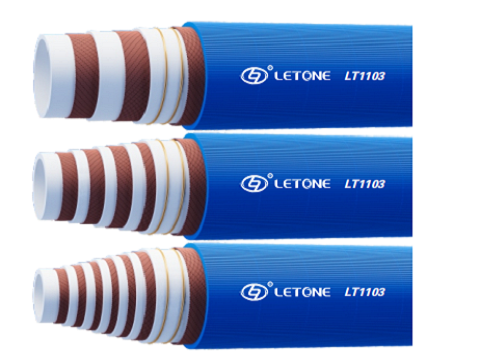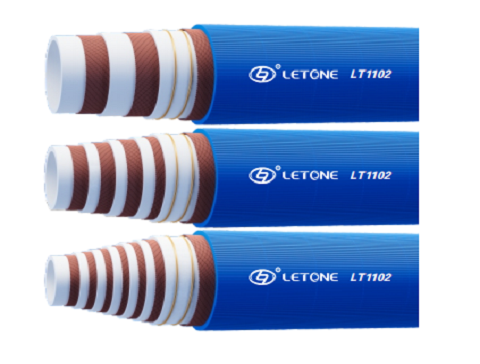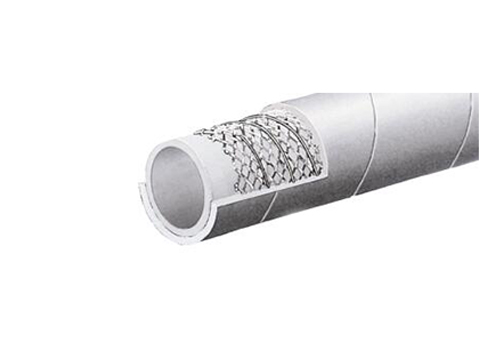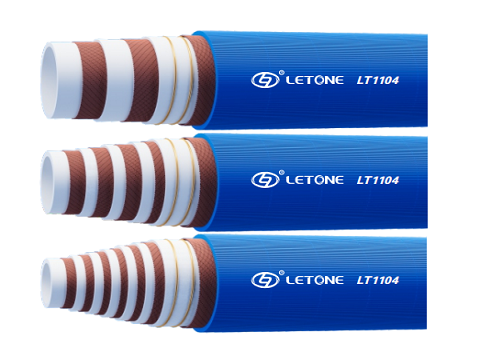Wire wound hydraulic hoses are an important hydraulic component widely used in various hydraulic systems. Its structural form and performance requirements are different from ordinary hydraulic hoses. This article will provide a detailed introduction to steel wire wound hydraulic hoses from the following aspects.
1、 Composition of steel wire wound hydraulic hoses
The steel wire wound hydraulic hose mainly consists of an inner adhesive layer, a steel wire layer, and an outer adhesive layer. The inner rubber layer directly contacts the hydraulic medium and requires oil resistance, high temperature resistance, and wear resistance; The steel wire layer is used to enhance the strength and withstand pressure of the hose; The outer adhesive layer serves to protect the steel wire layer, preventing the hose from mechanical damage or chemical corrosion.
2、 Characteristics of steel wire wound hydraulic hoses
1. High strength: Due to the presence of steel wire layers, steel wire wound hydraulic hoses have high strength and the ability to withstand pressure.
2. High temperature resistance: The inner and outer adhesive layers are usually made of high-temperature resistant materials and can work normally in high-temperature environments.
3. Wear resistance: The inner and outer rubber layers have good wear resistance, which can extend the service life of the hose.
4. Corrosion resistance: The outer adhesive layer can effectively prevent chemical corrosion of the hose, improving its reliability.
5. Easy installation: The steel wire wound hydraulic hose can be bent freely, making it easy to install and use.
3、 Selection principles for steel wire wound hydraulic hoses
1. Determine the working pressure and properties of the hydraulic medium.
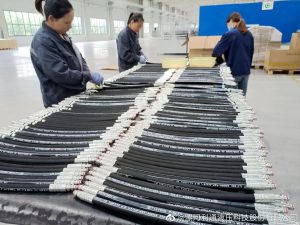 2. Determine the length and diameter of the required hose.
3. Choose appropriate materials and manufacturing processes.
4. Conduct cost analysis and comprehensively consider other technical parameters.
4、 Installation and maintenance of steel wire wound hydraulic hoses
When installing steel wire wound hydraulic hoses, excessive bending or twisting should be avoided to avoid damage.
2. When connecting hoses, appropriate connectors and seals should be used to ensure firm and good sealing.
During use, the hose should be regularly checked for leaks, damages, etc., and repaired or replaced in a timely manner.
During maintenance, attention should be paid to keeping the hoses clean and dry to prevent dirt and debris from entering the pipes.
5. When storing, avoid direct sunlight and high temperature environments to avoid affecting the performance and service life of the hose.
5、 The advantages and disadvantages of wire wound hydraulic hoses
1. Advantages: High strength, high temperature resistance, wear resistance, corrosion resistance, easy installation, etc.
2. Shortcomings: High costs, high requirements for manufacturing processes, and high requirements for usage environments.
6、 Future development trends
With the continuous progress of technology and the continuous development of industrial production, steel wire wound hydraulic hoses will have more application fields and development space in the future. In the future, steel wire wound hydraulic hoses will pay more attention to improving the environmental friendliness of materials, intelligent manufacturing processes, and adaptability to usage environments. At the same time, with the popularization and application of the industrial internet, the research and application of intelligent monitoring and maintenance in steel wire wound hydraulic hoses will be more emphasized.
In summary, as an important hydraulic component, steel wire wound hydraulic hoses will play a more important role in future development. At the same time, we should also pay attention to its existing problems and shortcomings, continuously innovate and improve technology, in order to better meet the needs of industrial production.
2. Determine the length and diameter of the required hose.
3. Choose appropriate materials and manufacturing processes.
4. Conduct cost analysis and comprehensively consider other technical parameters.
4、 Installation and maintenance of steel wire wound hydraulic hoses
When installing steel wire wound hydraulic hoses, excessive bending or twisting should be avoided to avoid damage.
2. When connecting hoses, appropriate connectors and seals should be used to ensure firm and good sealing.
During use, the hose should be regularly checked for leaks, damages, etc., and repaired or replaced in a timely manner.
During maintenance, attention should be paid to keeping the hoses clean and dry to prevent dirt and debris from entering the pipes.
5. When storing, avoid direct sunlight and high temperature environments to avoid affecting the performance and service life of the hose.
5、 The advantages and disadvantages of wire wound hydraulic hoses
1. Advantages: High strength, high temperature resistance, wear resistance, corrosion resistance, easy installation, etc.
2. Shortcomings: High costs, high requirements for manufacturing processes, and high requirements for usage environments.
6、 Future development trends
With the continuous progress of technology and the continuous development of industrial production, steel wire wound hydraulic hoses will have more application fields and development space in the future. In the future, steel wire wound hydraulic hoses will pay more attention to improving the environmental friendliness of materials, intelligent manufacturing processes, and adaptability to usage environments. At the same time, with the popularization and application of the industrial internet, the research and application of intelligent monitoring and maintenance in steel wire wound hydraulic hoses will be more emphasized.
In summary, as an important hydraulic component, steel wire wound hydraulic hoses will play a more important role in future development. At the same time, we should also pay attention to its existing problems and shortcomings, continuously innovate and improve technology, in order to better meet the needs of industrial production.

